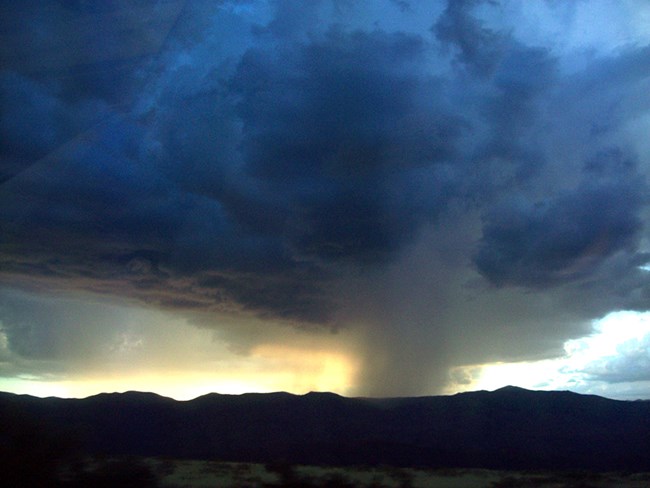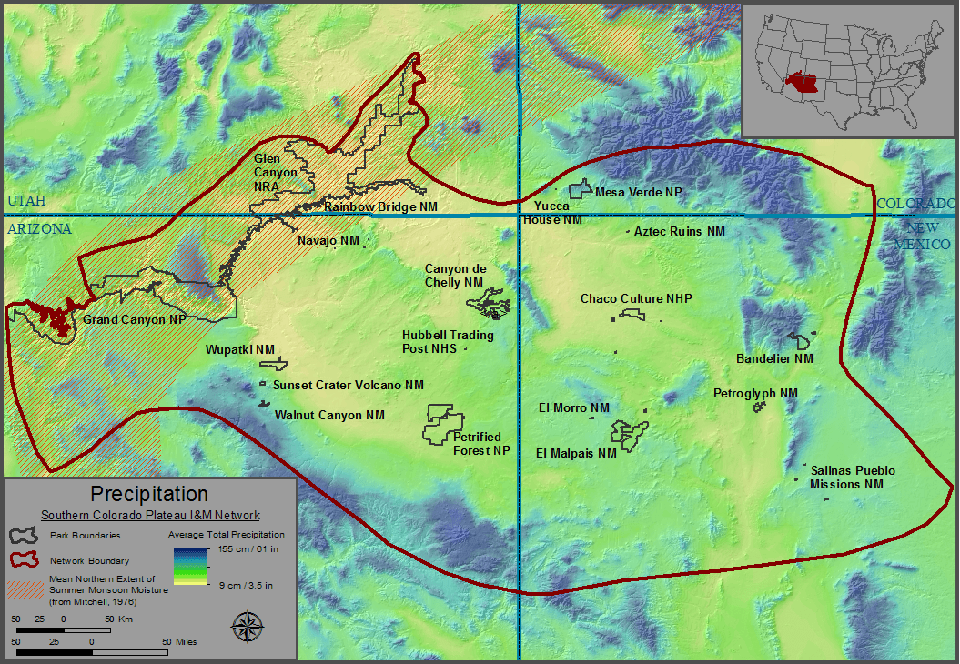
Michael Bencic
SCPN Monitoring Sites Webmap (NPS staff only)
The Southern Colorado Plateau lies in a zone of arid temperate climate, characterized by periods of drought and variable precipitation, warm to hot growing seasons, and long winters with extended periods of freezing temperatures.
Many of the Southern Colorado Plateau Network (SCPN) parks experience a bi-modal precipitation pattern, with most precipitation occurring during the summer monsoon season and the winter months. However, much of the moisture is lost through evaporation, due to high noontime solar radiation, clear skies, and dry, thin, high-elevation air.
The northern boundary of the network roughly aligns with the northwestern extent of summer monsoonal precipitation. The amount of summer precipitation generally weakens from southeast to northwest. This may contribute to the high inter-seasonal and inter-annual variability in precipitation on the Southern Colorado Plateau.

NPS / SCPN
Weather Stations
Ground-based weather stations are the primary source of climate information for every NPS park unit. These stations typically have temperature and precipitation sensors. They may also measure wind speed and direction, atmospheric pressure, and humidity.
When collected over many years these data provide important information about parks, including:
-
long term climate averages
-
trends in weather data through time
-
magnitude and frequency of extreme weather events
- weather data for specific days or months in the past
Before using weather station datasets to look for long-term trends, the datasets must be examined for local non-weather caused anomalies. These anomalies include things like
- changes in station measuring equipment
- changes in station location
- changes in local station conditions, like shading from buildings
We can look at long-term variability and trends in weather using records that have been adjusted for those effects, for example, records from stations in the U.S. Historical Climatology Network. We can also use records from stations specifically designed to collect long-term climate data, like those in the U.S. Climate Reference Network.
SCPN does not maintain a weather station network, but uses station data available from multiple networks. SCPN has created an interactive map that identifies current and historic weather stations near network parks. We update this map periodically, as we learn of new stations, or changes in station status.

NPS / SCPN
Climate Summary Chart
Climate charts are summaries of average climatic variables over time. They most often display monthly averages for temperature and precipitation over a year. A special category of climate chart, called a Walter-Leith diagram, scales temperature and precipitation axes to highlight arid and moist periods of the year. When the precipitation curve undercuts the temperature curve, the area between the curves represents a dry season. When the temperature curve undercuts the precipitation curve, the area between the curves represents a moist period.
Although climate patterns on the Colorado Plateau vary, SCPN weather stations reveal general patterns:
-
Precipitation decreases from high elevations to low elevations.
-
Summer precipitation decreases from the southeastern portion of the Plateau to the northwest.
Pictured here is an example of a climate summary chart for El Malpais National Monument. It is based on the diagrams developed for the Climate Diagram World Atlas by Walter and Lieth, 1967.
Project Contact:
Jodi Norris, Landscape and Quantitative Ecologist
Monitored in These Parks
- Aztec Ruins National Monument
- Bandelier National Monument
- Canyon de Chelly National Monument
- Chaco Culture National Historical Park
- El Malpais National Monument
- El Morro National Monument
- Glen Canyon National Recreation Area
- Grand Canyon National Park
- Hubbell Trading Post National Historic Site
- Mesa Verde National Park
- Navajo National Monument
- Petrified Forest National Park
- Petroglyph National Monument
- Rainbow Bridge National Monument
- Salinas Pueblo Missions National Monument
- Sunset Crater Volcano National Monument
- Walnut Canyon National Monument
- Wupatki National Monument
- Yucca House National Monument
Reports and Publications
Looking for information about the effects of climate change on a particular park? Please visit the Park-specific Climate Science page on the National Park Service Climate Change subject site.Source: NPS DataStore Collection 7701. To search for additional information, visit the NPS DataStore.
Last updated: February 6, 2025
